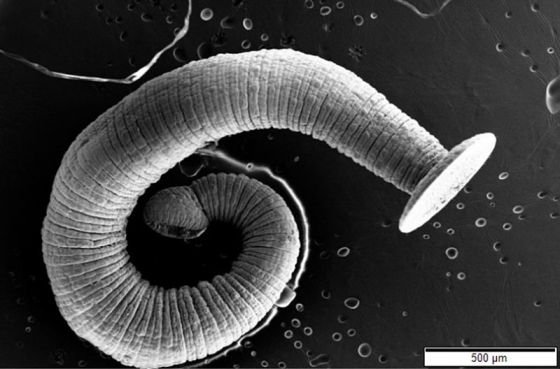So, you’ve noticed that your cat is shedding worms and the cat worms look like sesame seeds? That’s an indication your cat has tapeworms.
Tapeworms are relatively common in cats. Luckily, they are not necessarily harmful to your feline friend. But that is only valid if your cat is promptly treated when the tapeworms are noticed.
If you leave your cat untreated until you notice signs of tapeworm infection, your cat’s situation can get complicated. With this article, we want to protect your cat from tapeworm complications by giving you all the relevant information. Let’s start with the basics.
What are Cat Tapeworms?
Tapeworms are flat, ribbon-like intestinal parasites that infect cats and dogs. Cats can get any of the four types of tapeworms, but Dipylidium caninum is the most common tapeworm among cats in the US.

When a cat ingests tapeworm eggs, they mature into adult tapeworms. The tapeworms then anchor themselves to the wall of the cat’s small intestines. Adult tapeworms can grow to about 11″ (30cm).
At maturity, tapeworms develop segments known as proglottids. Each of these segments measures around half an inch (12mm). Proglottids at the tail end of a tapeworm break off and are sent out with the cat’s feces.
You may notice tapeworm proglottids moving around your cat’s anus or on freshly passed cat feces. These segments are what many people refer to when they ask which cat worms look like rice.
When proglottids dry up, they turn golden and break open to release the tapeworm eggs. The eggs infect other cats and pets with tapeworms when ingested in fleas. A single tapeworm segment can contain as many as 20 eggs. And that’s how the tapeworm cycle is perpetuated.
How Do Cats Get Tapeworms?
Cats typically get tapeworms by ingesting fleas that are intermediate hosts for the worms. That’s because tapeworms have a complex lifecycle, as illustrated:

Mice and squirrels can sometimes act as hosts and pass the parasite to cats when they hunt them. This happens with the Taenia taeniaeformis type of tapeworm.
Once in the cat’s intestines, tapeworm larvae attach to the cat’s intestines and mature into adult worms.
Which Cats are More Likely to Get Tapeworms?
Cats only get infected with tapeworms when they ingest infected intermediate hosts (usually fleas). As such, cats with fleas are highly susceptible to tapeworm infection.
This dependency creates the commonly discussed link between cat worms and fleas. It also explains why cat worms and flea treatment should be done simultaneously.
What are the Signs my Cat has Tapeworms?
Tapeworms in cats are usually asymptomatic and will usually not cause severe illness in cats. As such, most cat owners will only notice that their feline friend has tapeworms if they see the proglottids. The segments can be found in the cat’s feces, around the pet’s anus, or on the pet’s bedding.
That said, cats with heavy tapeworm burden can show other clinical signs, including:
- Weight loss (retarded growth in kittens).
- Poor coat quality.
- Increased appetite
- Irritability and restlessness.
- Diarrhea.
- Seizures (in severe cases).
- Intestinal blockages.
- Scooting the anus along a carpet or on the ground to ease discomfort from proglottids.
- Vomiting worms, if the tapeworms migrate to the stomach.
These signs can suggest to cat owners that their pet is infected with tapeworms. To confirm your suspicion, vets will run tests for a positive diagnose.
How are Tapeworms in Cats Diagnosed?

Veterinarians usually test cats for tapeworms using fecal floatation. This procedure detects the presence of tapeworm segments in the stool. However, tapeworm proglottids are not shed regularly with cat feces. This can make diagnosis quite difficult.
To help the vet diagnose your cat for tapeworms, collect tapeworm segments and bring the sample for testing. A positive test will necessitate immediate treatment.
What is the Treatment for Cats with Tapeworms?
Cat tapeworm treatment should be prescribed by a professional vet. Prescriptions can include meds such as Praziquantel and Epsiprantel. Treatment for fleas should also be given.
In severe infections, diagnostic imaging and corrective procedures may be required, especially if an intestinal blockage is suspected.
Cat Tapeworm Prevention
It’s important to keep your cat free of tapeworms to preempt any health complications. Besides, tapeworms have a zoonoses risk, which makes cat worms dangerous to humans.
If you are wondering, the primary way is to keep cats free of fleas. Do that by:
- Administering the year-round flea preventative treatment.
- Cleaning up after your pets and avoid leaving cat feces lying around in your compound. Fleas pick tapeworm eggs from infected cat and dog feces.
Although many people often ask if there’s a vaccine for tapeworms in cats, the fact is there is no vaccine for tapeworms. Deworming your cat during regular vaccination vet visits is advised.
Concluding Thoughts
Cats live with us in our homes. For this reason, it is normal to wonder what cat worms are contagious to humans and can cat tapeworms infect humans.
Tapeworms in cats can be contagious for humans or other pets. Children can easily get tapeworms if they ingest fleas. This can happen when playing with dirt or with a cat.
Keeping your cat free of fleas keeps tapeworms away!
Featured Image Credit: Image contributed by the Georgia Division of Public Health., Public domain, via Wikimedia Commons
